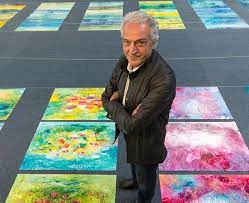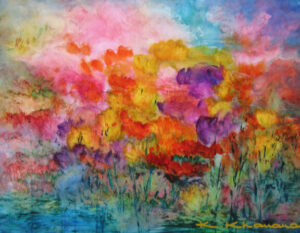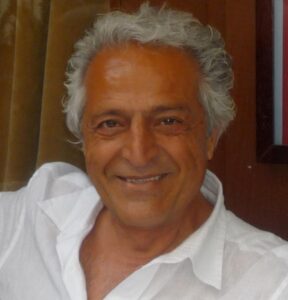 Kamran Khavarani creator of Abstract Romanticism
Kamran Khavarani creator of Abstract Romanticism
Kamran Khavarani was born into an artistic family in Iran in 1941. He started painting at the age of three and when he was twelve years old, he began to study classical painting with the well-known artist, Reza Samimi.
Mr. Khavarani completed his education in 1966 from Tehran University with a Master’s degree in Architecture and a Ph.D. in Urban Design. His graduate work was done under the guidance of his Mentor Master Houshang Seyhoun, the internationally renowned Iranian authority in art and architecture.
Khavarani has won numerous architectural awards and recognitions such as: ‘California Building Official’s highest award of excellence’ for single family residence, the design award for the ‘City Theatre of Tehran’ which was an international competition. His paintings are housed in many private art collections.
His earlier paintings were influenced by his classical and formal training in arts and architecture. Since his recent encounters with the philosophy of Rumi and other great teachers, both the artist and his art have been transformed and his current paintings carry subtle mystical messages.
By combining unique movements of color with a play of emotions, Kamran Khavarani creates a rare fusion of Romanticism with the abstraction
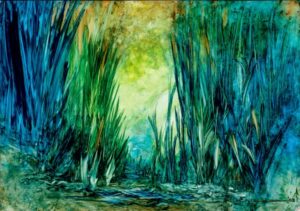
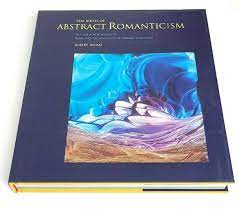
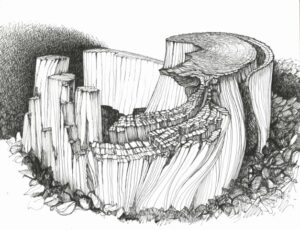
Exalted by the love poems of the thirteenth-century Persian poet, Jalaluddin Rumi, Kamran Khavarani seeks to translate his ecstatic feelings into visual harmonies that celebrate the idea of Presence, the loving, creative side of existence potentially in everything and everyone.
With broad sweeping gestures rippling horizontally across the surface in brilliant and unconventional hues of blue-greens, purples, yellow-greens and oranges, Khavarani visually expresses his inner response to Rumi, evoking the oceanic and cosmic metaphors of the Persian mystic. Assigning to each of the four elements, earth, air, fire and water, its own unique color register, he gives his primordial visions – most evident in his glowing ‘Creation’ (2003) – a riveting presence.
We may define his unusual approach as Abstract Romanticism, bringing emotion and beauty into the here and now with an intense energy and spontaneity that manifests fulfillment of joy in the eternal present. This is perhaps the most apt term to designate his layered, billowing striations of dazzling color that often evoke shimmering fields of sunset and sunrise effects, the blending of heaven and earth, the living sea washing over us, rejuvenating and elevating the mind to that state of creative union in which the ego ceases to dictate and consciousness merges with the universe of the Beloved. In this way, Khavarani resurrects the romantic idea of the possibility of an art that can change the world by reaching out unstintingly to the heart and imagination of the individual spectator
Albert Boime, professor of Art History, UCLA
February 2005
The Romantic principles of spontaneous expression, intuition, mystery and inner truth guided William Blake (1757-1827) (also an important poet), whose paintings illustrated his complex prophetic vision, and William Turner (1775-1851), who painted intense, dramatic landscapes which became his path to create pure forms of oceanic scenes making him the father of Abstract Figurative art in the first half of the 19th century.
Kamran Khavarani is the heir to Blake and Turner as a painter of a new artistic outlook that should be known as Abstract Romanticism. This resembles the declarations of art critics in the mid 20th century that described the art of the New York School Artists Mark Rothko (1903-1970) and Jackson Pollock (1912-1956) as Abstract Expressionism. They shared an emphasis on the non-representational physicality of the painting and emotional engagement with the viewers.
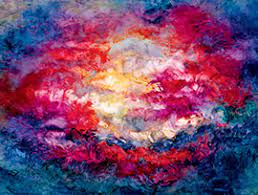
Khavarani’s massive array of light and colors mixed with myth and poetic current bears the trace of motion and emotions. He often prefers bare hands to traditional instruments (brush, sticks or palette knife) to incorporate the art of painting into the work itself. He forms highly expressive movements and dimensional values to communicate inner impulses and the obscurity of mythology and poetry to the viewers of his art.
Read more on original:
